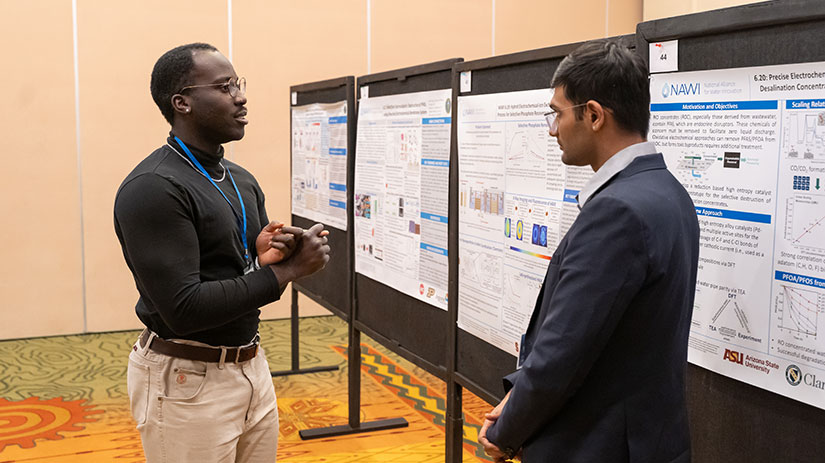Water Research Hub Earns 5 More Years of Funding
The National Alliance for Water Innovation Will Continue Work To Make US Water Supplies More Accessible, Affordable, and Energy Efficient

Most Americans get their water from traditional sources, like large freshwater reservoirs or groundwater—fresh, underground rivers flowing beneath our feet.
But change is coming.
Climate change, population growth, and increased industrial and agricultural production are several factors (among many) that are stressing U.S. and global freshwater supplies.
“To supply the water needs of the future, it is critical that the United States develop technologies that provide alternative water sources,” said Abhishek Roy, a senior staff scientist at the National Renewable Energy Laboratory (NREL) and member of the National Alliance for Water Innovation (NAWI).
And NAWI is doing exactly that.
A National Hub Earns More Support
First launched in 2019, NAWI is a research hub that brings together a world-class team of partners from industry and academia, as well as the hub’s public membership organization, called the NAWI Alliance. Together, these experts and water treatment stakeholders are working to lower the cost and energy of water purification technologies, including those that can transform nontraditional water sources, like wastewater or salty groundwater, into clean drinking water.
As of April 2024, NAWI has been extended for five more years, so the team can continue to hone water treatment technologies and increase access to clean drinking water for all Americans, all while reducing the energy and emissions associated with water treatment processes. The organization has received $75 million in funding from two U.S. Department of Energy (DOE) offices: the Industrial Efficiency and Decarbonization Office and the Water Power Technologies Office.
“The extension is great news,” said Matthew Ringer, the laboratory program manager for advanced manufacturing at NREL and NAWI’s partnerships director. “NAWI has more than 460 organizations and more than 1,800 members from around the world who are working together to help produce secure, reliable, and affordable water for communities that are most in need.”
NAWI is led by DOE’s Lawrence Berkeley National Laboratory in partnership with NREL, Oak Ridge National Laboratory, and the National Energy Technology Laboratory.
A Master Road Map to More Secure, Affordable Water
In its first five years, NAWI accomplished a lot—with help from its many members, including researchers at NREL. NREL’s Jordan Macknick led an early NAWI win: a master road map that identifies the highest-priority research needs for water desalination (or purification) and where such technologies are already in use. From the beginning, this road map helped NAWI members optimize their investments; it also serves as the foundation—and future guide—for NAWI’s five-year extension. Macknick also leads one of NAWI’s core research areas—the Data Modeling and Analysis topic area—which focuses on analyzing the cost, efficiency, and performance of entire water treatment systems.
This type of research also happens to be one of NREL’s areas of expertise.
For example, NREL’s Kurban Sitterley helped improve an open-source software tool that can assess the technological and economic value of more than 60 different water treatment technologies. Water treatment researchers and facilities can use the tool, called the Water Treatment Technoeconomic Assessment Platform (or WaterTAP), to evaluate technologies that could help reduce their costs and energy consumption while continuing to meet existing and future water demands. (Sitterley also developed a new model for WaterTAP that can evaluate one of the most promising ways to remove forever chemicals and other contaminants from drinking water).
Plus, WaterTAP can help assess how water treatment facilities could use renewable energy resources, like solar, wind, and geothermal, along with batteries to power their facilities without raising their costs. Some community-scale treatment systems could even provide water for disaster relief and recovery missions or remote military deployments.
“This funding extension is essential to continue the maturation of these technologies and improve their cost and performance,” said Scott Struck, a senior integrated water systems research scientist at NREL.
Solutions for Communities With Dwindling or Contaminated Water Supplies
Struck appreciates how much NAWI has advanced water treatment tools, technologies, policies, and planning. But he is especially excited about NAWI’s work with communities. Even in the United States, not all communities have access to uncontaminated drinking water. In one area of the Central Valley of California, the available drinking water contains high levels of arsenic (a carcinogen), making it unsafe to drink. Because the community is small and financially unable to shoulder the costs of a centralized water treatment system, the residents resorted to buying bottled water instead.
But with NAWI’s help, the community could receive a more affordable and sustainable solution: smaller, more modular water treatment technologies that can filter out enough arsenic to achieve drinking water standards. With that, the community could access a local, more affordable water supply.
In NAWI’s next five years—which has been dubbed NAWI 2.0—the organization will pursue more community-based projects to help Americans maintain affordable and effective drinking water even as hotter temperatures or droughts threaten their supplies. NAWI Alliance members will also continue to advance desalination and other novel technologies that can treat unconventional water sources and cut greenhouse gas emissions at the same time.
“NREL is excited that DOE has extended NAWI for another five years,” Ringer said. “We look forward to working with our partners in national labs, academia, and industry to drive solutions for decarbonizing water and wastewater sectors.”
“Working together,” Struck added, “the NAWI community will help secure a more sustainable and resilient water supply.”
Become a thought leader in clean water innovation and join the NAWI Alliance for free today to unite with world-class lab, industry, and academic experts to address some of the greatest water and energy security challenges.

